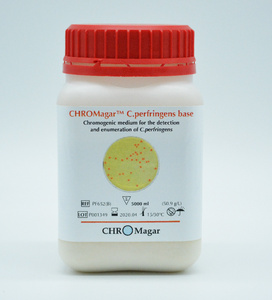CHROMagar™ C. perfringens Kit, 5000 mL Pack (Base medium + Supplement)
Catalog No :
CAS Number :
Brand :
In Stock
For detection and enumeration of Clostridium perfringens
Specifications:
| Application | Microbiology | ||
| Storage Temperature | Room Temperature | ||
| Product Type | Culture Medium | Forms | Powder |
| Product Brand | CHROMagar™ | ||
| Product Grade | Microbiology grade | ||
For Detection and Enumeration of Clostridium perfringens in Food, Water, and Clinical Samples
CHROMagar™ C. perfringens is a selective chromogenic culture medium designed for the direct detection, differentiation, and enumeration of Clostridium perfringens from food, environmental, and clinical samples. It allows easy visual identification of C. perfringens colonies as distinct orange colonies, while non-target flora such as Clostridioides difficile appear green to blue-green, and other organisms are inhibited.
Unlike traditional black colony-based methods (e.g., TSC agar), CHROMagar™ C. perfringens provides improved selectivity, readability, and enumeration efficiency with or without an overlay.
🔹 Key Features & Benefits
- ✅ Bright Orange Colonies for C. perfringens: Easily distinguishable from other flora without requiring dual-layer agar.
- ✅ More Specific than TSC: Unlike TSC (Tryptose Sulfite Cycloserine) agar, which detects sulfate-reducing organisms (both pathogenic and non-pathogenic), CHROMagar™ C. perfringens specifically targets Clostridium perfringens.
- ✅ Flexible Method Compatibility: Suitable for pour plate, surface streaking, spreading, or membrane filtration—no need for deep agar overlay techniques.
- ✅ Improved Accuracy and Readability: Avoids the black colony fade seen with TSC media (per ISO 14189), ensuring reliable enumeration even after extended incubation.
- ✅ Differentiation from C. difficile: Clostridioides difficile appears as green-blue to green colonies, aiding in rapid presumptive differentiation.
🔹 Colony Appearance
| Organism | Colony Appearance |
|---|---|
| Clostridium perfringens | Orange |
| Clostridioides difficile | Green-blue to green |
| Other flora | Inhibited or not distinguishable |
🔹 Intended Use
CHROMagar™ C. perfringens is intended for:
-
Qualitative detection and enumeration of C. perfringens in:
- Cooked, dried, or processed foods
- Environmental samples (e.g., water, surfaces)
- Veterinary and clinical stool specimens
- Regulatory and quality control in food production and public health testing labs
- An alternative to TSC medium for more selective enumeration of C. perfringens
⚠️ Not intended for diagnosis of infection or therapeutic guidance. Confirmation of suspect colonies through further testing is recommended.
🔹 Clinical & Food Safety Background
Clostridium perfringens is a spore-forming anaerobic bacterium commonly found in the environment and the gastrointestinal tract. It is one of the most frequently implicated pathogens in foodborne illness outbreaks, particularly in:
- Reheated or poorly stored meat-based dishes (e.g., beef, poultry, gravies)
- Large-scale food preparation with prolonged warming conditions
Populations at risk include the elderly, immunocompromised, and infants, who may experience severe gastrointestinal symptoms, dehydration, and prolonged illness.
📌 CDC estimate: One of the top five bacterial causes of food poisoning in the U.S.
🔹 Test Procedure
- Sample Types: Food, water, surface swabs, clinical stools
-
Inoculation:
- Pour plate
- Direct streaking
- Surface spreading
- Membrane filtration
-
Incubation:
- Anaerobic conditions
- Temperature: 37 °C
- Time: 18–24 hours
-
Interpretation:
- C. perfringens = orange colonies
- C. difficile = green to green-blue colonies
- Other = inhibited or non-specific
🔹 Ordering Information
| Product Description | Reference Code | Components Included |
|---|---|---|
| CHROMagar™ C. perfringens 5000 mL | PF652 | Base PF652(B) + Supplement PF652(S1) + Supplement PF652(S2) |
🔹 Storage & Shelf Life
- Storage Conditions: 2–8 °C, dry and protected from light
- Shelf Life: Up to 24 months from date of manufacture
- Prepared Media: Use within validated shelf-life under aseptic conditions
CHROMagar™ C. perfringens delivers a highly specific, rapid, and visually distinct method for the detection and enumeration of C. perfringens, overcoming the limitations of traditional TSC-based agar. Its unique orange chromogenic signal, flexibility across inoculation methods, and improved accuracy make it an ideal choice for food safety testing, public health surveillance, and routine QC in processing facilities.




 0
0







